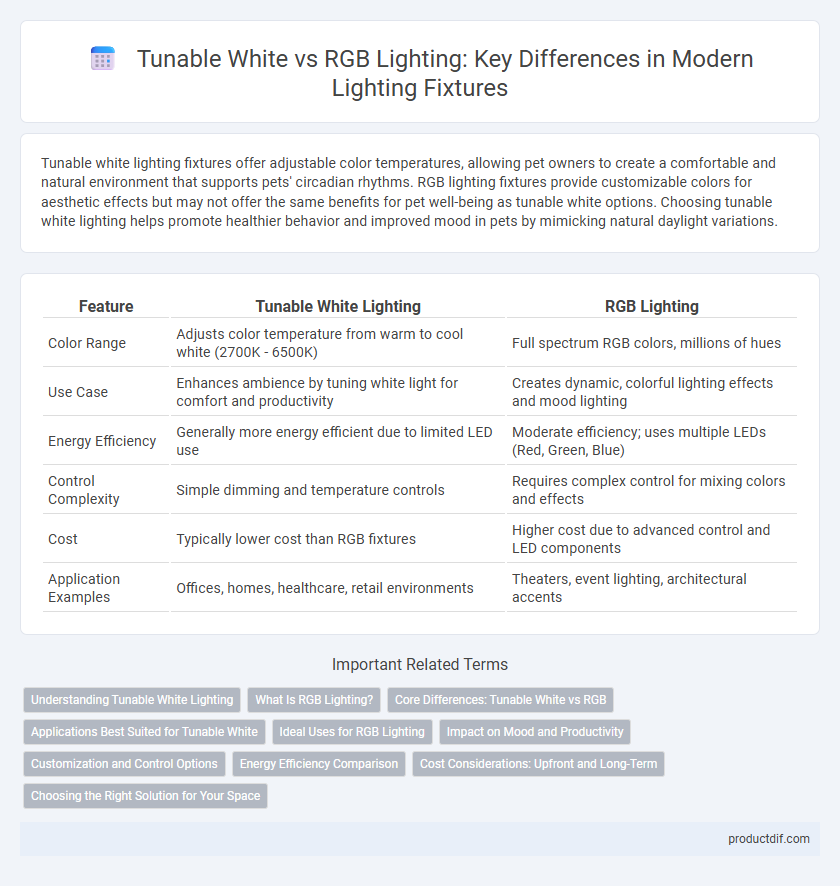Tunable white lighting fixtures offer adjustable color temperatures, allowing pet owners to create a comfortable and natural environment that supports pets' circadian rhythms. RGB lighting fixtures provide customizable colors for aesthetic effects but may not offer the same benefits for pet well-being as tunable white options. Choosing tunable white lighting helps promote healthier behavior and improved mood in pets by mimicking natural daylight variations.
Table of Comparison
| Feature | Tunable White Lighting | RGB Lighting |
|---|---|---|
| Color Range | Adjusts color temperature from warm to cool white (2700K - 6500K) | Full spectrum RGB colors, millions of hues |
| Use Case | Enhances ambience by tuning white light for comfort and productivity | Creates dynamic, colorful lighting effects and mood lighting |
| Energy Efficiency | Generally more energy efficient due to limited LED use | Moderate efficiency; uses multiple LEDs (Red, Green, Blue) |
| Control Complexity | Simple dimming and temperature controls | Requires complex control for mixing colors and effects |
| Cost | Typically lower cost than RGB fixtures | Higher cost due to advanced control and LED components |
| Application Examples | Offices, homes, healthcare, retail environments | Theaters, event lighting, architectural accents |
Understanding Tunable White Lighting
Tunable white lighting allows precise adjustment of color temperature from warm to cool white, optimizing ambiance and visual comfort for different tasks and times of day. Unlike RGB lighting, which combines red, green, and blue LEDs to create a wide color spectrum, tunable white lighting specifically enhances circadian rhythm alignment by mimicking natural daylight variations. This feature makes tunable white fixtures ideal for environments that benefit from dynamic white light control, such as offices, healthcare facilities, and residential spaces.
What Is RGB Lighting?
RGB lighting uses red, green, and blue LEDs to create a wide spectrum of colors by adjusting the intensity of each primary color. This type of lighting is popular for dynamic color effects, mood lighting, and decorative applications where vibrant and customizable hues are desired. Unlike tunable white lighting, which adjusts only white light temperature, RGB lighting offers full-color versatility for immersive visual experiences.
Core Differences: Tunable White vs RGB
Tunable white lighting offers precise control over color temperature, ranging from warm to cool white light, optimizing ambiance and visual comfort for various activities. RGB lighting combines red, green, and blue LEDs to produce a wide spectrum of colors, enhancing mood and decorative effects with vibrant hues. The core difference lies in tunable white's focus on color temperature adjustment, whereas RGB emphasizes full-color customization and dynamic color changes.
Applications Best Suited for Tunable White
Tunable white lighting provides precise control over color temperature, making it ideal for applications requiring circadian rhythm support, such as healthcare facilities, offices, and educational environments. This lighting enhances productivity and well-being by mimicking natural daylight patterns, promoting alertness during the day and relaxation in the evening. Unlike RGB lighting, which excels in dynamic color effects, tunable white is best suited for functional, human-centric illumination where color accuracy and visual comfort are priorities.
Ideal Uses for RGB Lighting
RGB lighting is ideal for environments requiring dynamic color changes and customizable atmospheres, such as entertainment venues, retail displays, and event spaces. It offers a broad spectrum of colors, enabling mood lighting and visual effects that enhance ambiance and engagement. RGB fixtures excel in applications where vibrant, programmable lighting is essential for creating immersive experiences.
Impact on Mood and Productivity
Tunable white lighting allows precise adjustment of color temperature, enhancing alertness and concentration by mimicking natural daylight patterns, which positively influences mood and productivity. RGB lighting offers customizable colors for ambiance and creativity stimulation but may lack the consistent circadian rhythm benefits of tunable white light. Studies show tunable white lighting reduces fatigue and improves task performance in work environments more effectively than RGB setups.
Customization and Control Options
Tunable white lighting offers precise control over color temperature, enabling users to adjust between warm and cool white tones to match circadian rhythms and enhance mood. RGB lighting provides full-spectrum color customization, allowing for dynamic color effects and personalized ambiance through millions of color combinations. Both systems support smart controls and automation, but tunable white excels in functional lighting scenarios, while RGB emphasizes aesthetic versatility.
Energy Efficiency Comparison
Tunable white lighting offers superior energy efficiency by adjusting color temperature using a single LED source with varying intensities, resulting in lower power consumption compared to RGB lighting that requires multiple LEDs for red, green, and blue. RGB lighting consumes more energy due to the need to mix colors from separate diodes, often leading to higher heat output and reduced lifespan. Energy savings with tunable white systems can reach up to 30% when optimized for human-centric lighting and reduced color mixing inefficiencies.
Cost Considerations: Upfront and Long-Term
Tunable white lighting systems typically have lower upfront costs compared to RGB setups due to simpler components and control mechanisms. Long-term expenses for tunable white fixtures are generally reduced as they consume less energy and have longer LED lifespans, minimizing maintenance and replacement frequencies. RGB lighting often incurs higher initial investments and ongoing costs due to complex color mixing technology and increased power usage.
Choosing the Right Solution for Your Space
Tunable white lighting provides adjustable color temperatures from warm to cool white, enhancing ambiance and supporting circadian rhythms in residential and commercial spaces. RGB lighting offers vibrant color options, ideal for dynamic and creative environments where mood and aesthetic flexibility are priorities. Selecting between tunable white and RGB lighting depends on the desired atmosphere, functional needs, and the specific purpose of the space.
Tunable white vs RGB lighting Infographic

 productdif.com
productdif.com